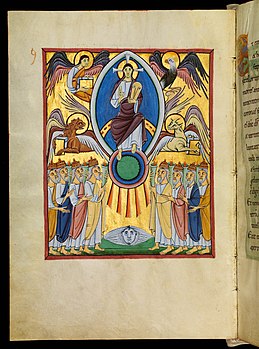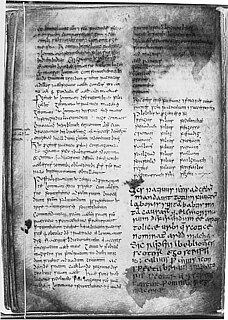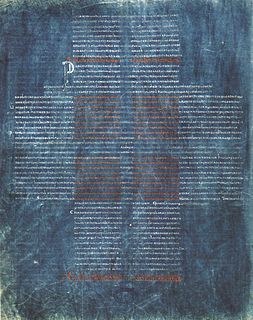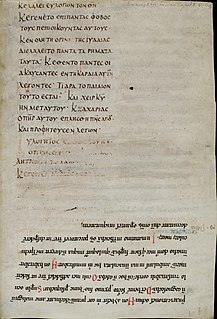 W
WThe Vulgate is a late-4th-century Latin translation of the Bible that was to become the Catholic Church's officially promulgated Latin version of the Bible during the 16th century, and is still used fundamentally in the Latin Church to this day.
 W
WThe Codex Amiatinus is the earliest surviving complete manuscript of the Latin Vulgate version of the Christian Bible. It was produced around 700 in the north-east of England, at the Benedictine monastery of Monkwearmouth–Jarrow in the Anglo-Saxon Kingdom of Northumbria and taken to Italy as a gift for Pope Gregory II in 716. It was one of three giant single-volume Bibles then made at Monkwearmouth–Jarrow, and is the earliest complete one-volume Latin Bible to survive, only the León palimpsest being older; and the oldest bible where all the Books of the Bible present what would be their Vulgate texts.
 W
WThe Bamberg Apocalypse is an 11th-century richly illuminated manuscript containing the pictorial cycle of the Book of Revelation and a Gospel Lectionary of the books of pericopes. This medieval illuminated manuscript was created during the Ottonian dynasty; it is unknown whether it was commissioned by Otto III or Henry II. It was completed sometime between 1000 and 1020. There is proof that Henry II donated this illuminated manuscript in 1020 to Collegiate Abbey of St. Stephan, on the occasion of its inauguration. The Bamberg Apocalypse is now located in the Bamberg State Library.
 W
WThe Book of Armagh or Codex Ardmachanus, also known as the Canon of Patrick and the Liber Ar(d)machanus, is a 9th-century Irish illuminated manuscript written mainly in Latin. It is held by the Library of Trinity College Dublin. The document is valuable for containing early texts relating to St Patrick and some of the oldest surviving specimens of Old Irish, and for being one of the earliest manuscripts produced by an insular church to contain a near complete copy of the New Testament.
 W
WThe Book of Kells is an illuminated manuscript Gospel book in Latin, containing the four Gospels of the New Testament together with various prefatory texts and tables. It was created in a Columban monastery in either Scotland, England or Ireland and may have had contributions from various Columban institutions from each of these areas. It is believed to have been created c. 800 AD. The text of the Gospels is largely drawn from the Vulgate, although it also includes several passages drawn from the earlier versions of the Bible known as the Vetus Latina. It is a masterwork of Western calligraphy and represents the pinnacle of Insular illumination. It is also widely regarded as one of Ireland's finest national treasures. The manuscript takes its name from the Abbey of Kells, which was its home for centuries.
 W
WThe Bible of Borso d'Este is a two volume manuscript. The illuminated miniatures, work of Taddeo Crivelli and others, were executed between 1455 and 1461. The work is held in the Biblioteca Estense di Modena
 W
WBritish Library, Harley MS 1775 is an illuminated Gospel Book produced in Italy during the last quarter of the 6th century. The text is in Latin and is a mixture of the Vulgate and Old Latin translations. This text is called "source Z" in critical studies of the Latin New Testament.
 W
WThe Ceolfrid Bible is a fragment of a late 7th or early 8th century Bible. It is almost certainly a portion of one of the three single-volume Bibles ordered made by Ceolfrid, Abbot of Monkwearmouth-Jarrow. It is closely related to the Codex Amiatinus, which is the only surviving complete Bible of the three ordered by Ceolfrid. The eleven surviving vellum leaves of the manuscript contain portions of the Latin Vulgate text of the third and fourth Books of Kings.
 W
WThe Codex Aureus of Lorsch or Lorsch Gospels is an illuminated Gospel Book written in latin between 778 and 820, roughly coinciding with the period of Charlemagne's rule over the Frankish Empire. Both the manuscript and the carved ivory panels from the cover are rare and important survivals from the art of this period.
 W
WThe Codex Beneventanus is an 8th-century illuminated codex containing a Gospel Book. According to a subscription on folio 239 verso, the manuscript was written by a monk named Lupus for one Ato, who was probably Ato, abbot (736–760) of the monastery of San Vincenzo al Volturno, near Benevento. The unusual odd number of Canon Tables suggests these seven folios were prepared as much as two centuries earlier than the rest of the codex.
 W
WThe Codex Gigas is the largest extant medieval illuminated manuscript in the world, at a length of 92 cm (36 in). It is also known as the Devil's Bible because of a very unusual full-page portrait of the devil, and the legend surrounding its creation.
 W
WThe Egmond Gospels is a 9th-century Gospel Book written in Latin and accompanied by illustrations. It is named after the Egmond Abbey, to which it was given by Dirk II, and where it remained for six centuries. It is most famous for being the earliest surviving manuscript showing scenes with Dutch people and buildings, and represents one of the oldest surviving Christian art treasures from the Netherlands. The manuscript has been owned by the Royal Library of the Netherlands since 1830.
 W
WThe Codex Fuldensis, also known as the Victor Codex, designated by F, is a New Testament manuscript based on the Latin Vulgate made between 541 and 546. The codex is considered the second most important witness to the Vulgate text; and is also the oldest complete manuscript witness to the order of the Diatessaron. It is an important witness in any discussion about the authenticity of 1 Corinthians 14:34-35 and the Comma Johanneum. It is one of the earliest dated manuscripts of the New Testament. It was corrected until 2 May, 546 AD.
 W
WThe Giant Bible of Mainz is a very large manuscript Bible produced in 1452–53, probably in Mainz or nearby. It is notable for its beauty, for being one of the last manuscript Bibles written before the invention of printing in the West, and for its possible connections with the Gutenberg Bible.
 W
WEgerton MS 768, British Library, London is an illuminated Gospel Book in Latin produced in Northern France during the mid-9th century. It contains the Gospels of Luke and John. The manuscript 's decoration includes lavish two page incipits which are decorated with interlace patterns for each Gospel. It was purchased by the British Library by means of the Egerton Fund established by Francis Henry Egerton, 8th Earl of Bridgewater and forms part of the Egerton Collection.
 W
WThe La Cava Bible or Codex Cavensis is a 9th-century Latin illuminated Bible, which was produced in Spain, probably in the Kingdom of Asturias during the reign of Alfonso II. The manuscript is preserved at the abbey of La Trinità della Cava, near Cava de' Tirreni in Campania, Italy, and contains 330 vellum folios which measure 320 by 260 mm.
 W
WThe Lindisfarne Gospels is an illuminated manuscript gospel book probably produced around the years 715-720 in the monastery at Lindisfarne, off the coast of Northumberland, which is now in the British Library in London. The manuscript is one of the finest works in the unique style of Hiberno-Saxon or Insular art, combining Mediterranean, Anglo-Saxon and Celtic elements.
 W
WMinuscule 17, ε 525 (Soden). It is a Greek-Latin minuscule manuscript of the New Testament, on 354 parchment leaves, dated palaeographically to the 15th century. It has some marginalia.
 W
WMinuscule 165, ε 1320 (Soden), is a Greek-Latin minuscule manuscript of the New Testament, on parchment. It is dated by its colophon to the year 1292. It has complex contents. It has marginalia.
 W
WThe Pericopes of Henry II is a luxurious medieval illuminated manuscript made for Henry II, the last Ottonian Holy Roman Emperor, made c. 1002 – 1012 AD. The manuscript, which is lavishly illuminated, is a product of the Liuthar circle of illuminators, who were working in the Benedictine Abbey of Reichenau, which housed a scriptorium and artists' workshop that has a claim to having been the largest and artistically most influential in Europe during the late 10th and early 11th centuries. An unrivalled series of liturgical manuscripts was produced at Reichenau under the highest patronage of Ottonian society.
 W
WCodex Sangallensis, designated by Δ or 037, ε 76, is a diglot Greek-Latin uncial manuscript of the four Gospels. Usually it is dated palaeographically to the 9th, only according to the opinions of few palaeographers to the 10th century. It was named by Scholz in 1830.
 W
WThe Codex Sangallensis 63, designated S, is a 9th-century Latin manuscript of the New Testament. The text, written on vellum, is a version of the Latin Vulgate Bible and contains the text of the Acts of the Apostles, Epistles, Book of Revelation, and non-biblical material. The manuscript has not survived in a complete condition, some parts of it have been lost. The codex contains the Comma Johanneum.
 W
WThe Codex Sangallensis 907, designated S, is an 8th-century Latin manuscript of the New Testament. The text, written on vellum, is a version of the Latin Vulgate Bible. It contains the text of the Catholic epistles, Book of Revelation, and non-biblical material. The manuscript did not survived in a complete condition and some parts of it has been lost. The codex contains the Comma Johanneum.
 W
WCodex Sangallensis 1395 is a nineteenth-century compilation of fragments, and includes a 5th-century Latin manuscript of the New Testament, designated by Σ. The text, written on vellum, is a version of the Latin Vulgate.
 W
WThe Codex Claromontanus V, designated by h in traditional system or by 12 in the Beuron system, is a 4th or 5th century Latin manuscript of the New Testament. The text, written on vellum.
 W
WUncial 0130, ε 80 (Soden), is a Greek uncial manuscript of the New Testament, dated palaeographically to the 9th-century. Formerly it was labelled by Wc.